Analyzing 20 Future Trends for Project Delivery in Australia: Report
VerifiedAdded on 2020/05/08
|22
|5552
|114
Report
AI Summary
This report provides an analysis of future trends impacting project delivery in Australia. It begins with an executive summary highlighting current challenges in project implementation, including issues related to industrialization, globalization, and digitalization. The report then delves into these key areas, examining the impact of industrialization trends, such as technology incorporation, improved product quality, quick production, and reduced expenses. It also addresses the effects of digitalization, including high project costs, quality issues, and workforce challenges. The role of globalization is discussed, covering trade, transport, and communication. The report emphasizes how these trends will shape project delivery, offering insights into overcoming obstacles and achieving project goals. The conclusion summarizes the key findings and emphasizes the importance of adapting to these trends for successful project outcomes in Australia.
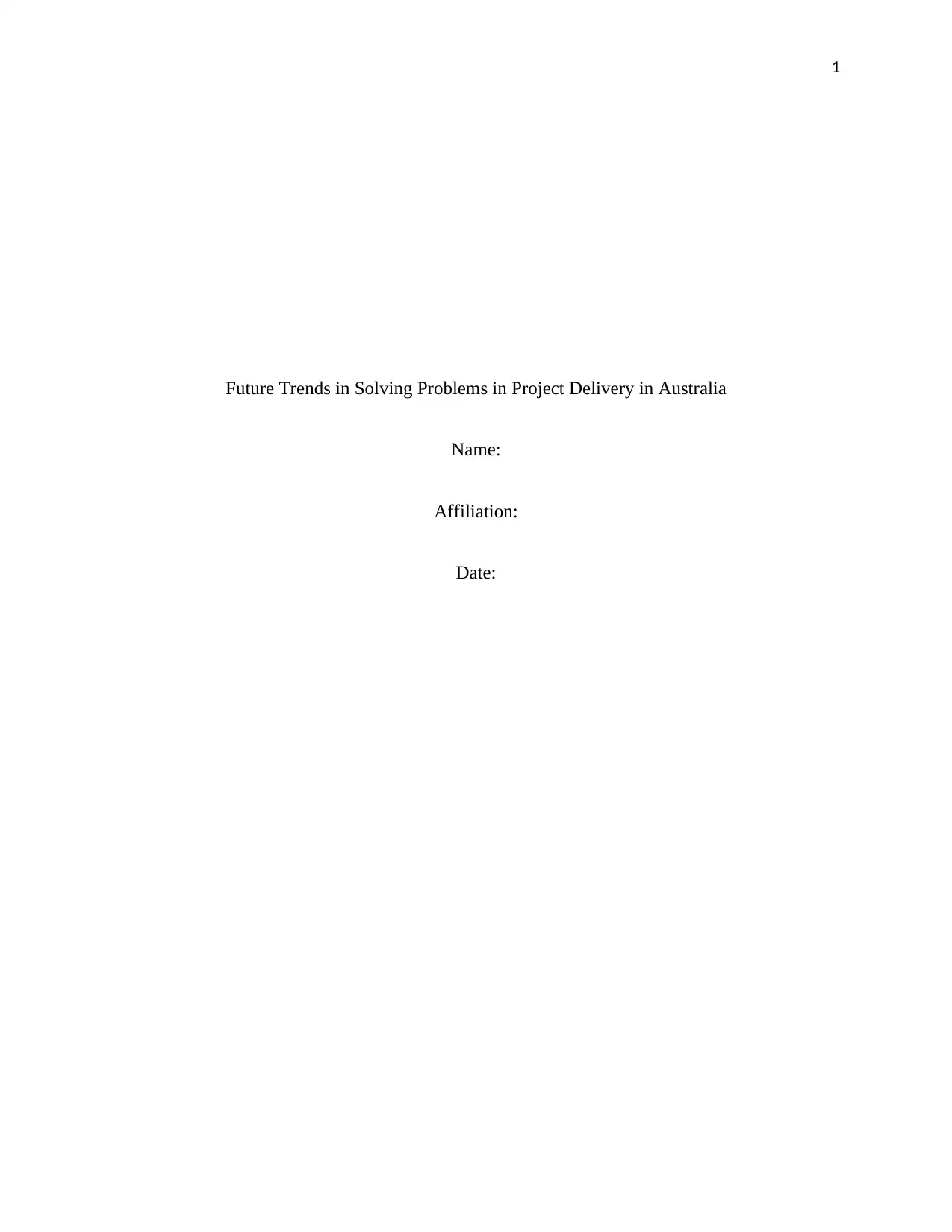
1
Future Trends in Solving Problems in Project Delivery in Australia
Name:
Affiliation:
Date:
Future Trends in Solving Problems in Project Delivery in Australia
Name:
Affiliation:
Date:
Paraphrase This Document
Need a fresh take? Get an instant paraphrase of this document with our AI Paraphraser
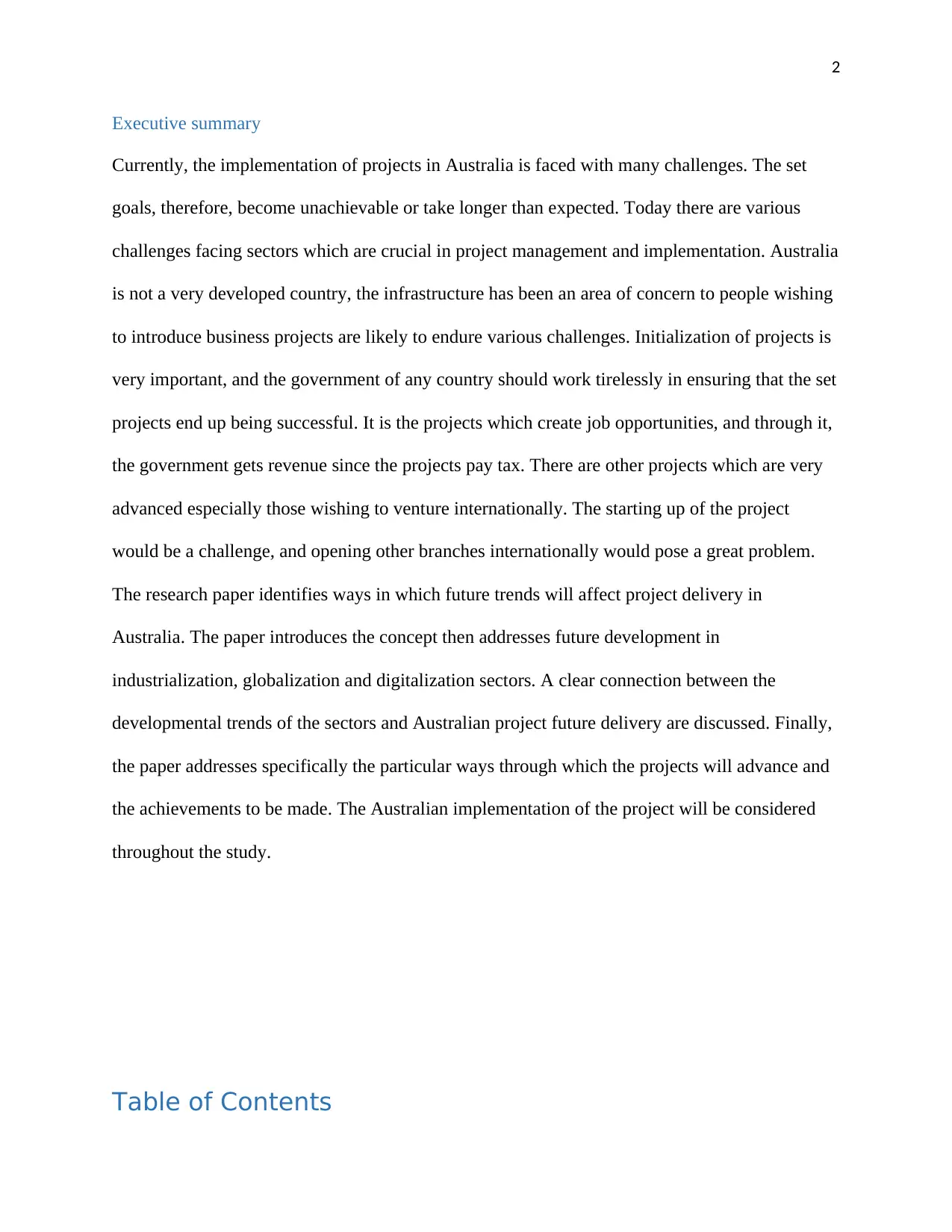
2
Executive summary
Currently, the implementation of projects in Australia is faced with many challenges. The set
goals, therefore, become unachievable or take longer than expected. Today there are various
challenges facing sectors which are crucial in project management and implementation. Australia
is not a very developed country, the infrastructure has been an area of concern to people wishing
to introduce business projects are likely to endure various challenges. Initialization of projects is
very important, and the government of any country should work tirelessly in ensuring that the set
projects end up being successful. It is the projects which create job opportunities, and through it,
the government gets revenue since the projects pay tax. There are other projects which are very
advanced especially those wishing to venture internationally. The starting up of the project
would be a challenge, and opening other branches internationally would pose a great problem.
The research paper identifies ways in which future trends will affect project delivery in
Australia. The paper introduces the concept then addresses future development in
industrialization, globalization and digitalization sectors. A clear connection between the
developmental trends of the sectors and Australian project future delivery are discussed. Finally,
the paper addresses specifically the particular ways through which the projects will advance and
the achievements to be made. The Australian implementation of the project will be considered
throughout the study.
Table of Contents
Executive summary
Currently, the implementation of projects in Australia is faced with many challenges. The set
goals, therefore, become unachievable or take longer than expected. Today there are various
challenges facing sectors which are crucial in project management and implementation. Australia
is not a very developed country, the infrastructure has been an area of concern to people wishing
to introduce business projects are likely to endure various challenges. Initialization of projects is
very important, and the government of any country should work tirelessly in ensuring that the set
projects end up being successful. It is the projects which create job opportunities, and through it,
the government gets revenue since the projects pay tax. There are other projects which are very
advanced especially those wishing to venture internationally. The starting up of the project
would be a challenge, and opening other branches internationally would pose a great problem.
The research paper identifies ways in which future trends will affect project delivery in
Australia. The paper introduces the concept then addresses future development in
industrialization, globalization and digitalization sectors. A clear connection between the
developmental trends of the sectors and Australian project future delivery are discussed. Finally,
the paper addresses specifically the particular ways through which the projects will advance and
the achievements to be made. The Australian implementation of the project will be considered
throughout the study.
Table of Contents
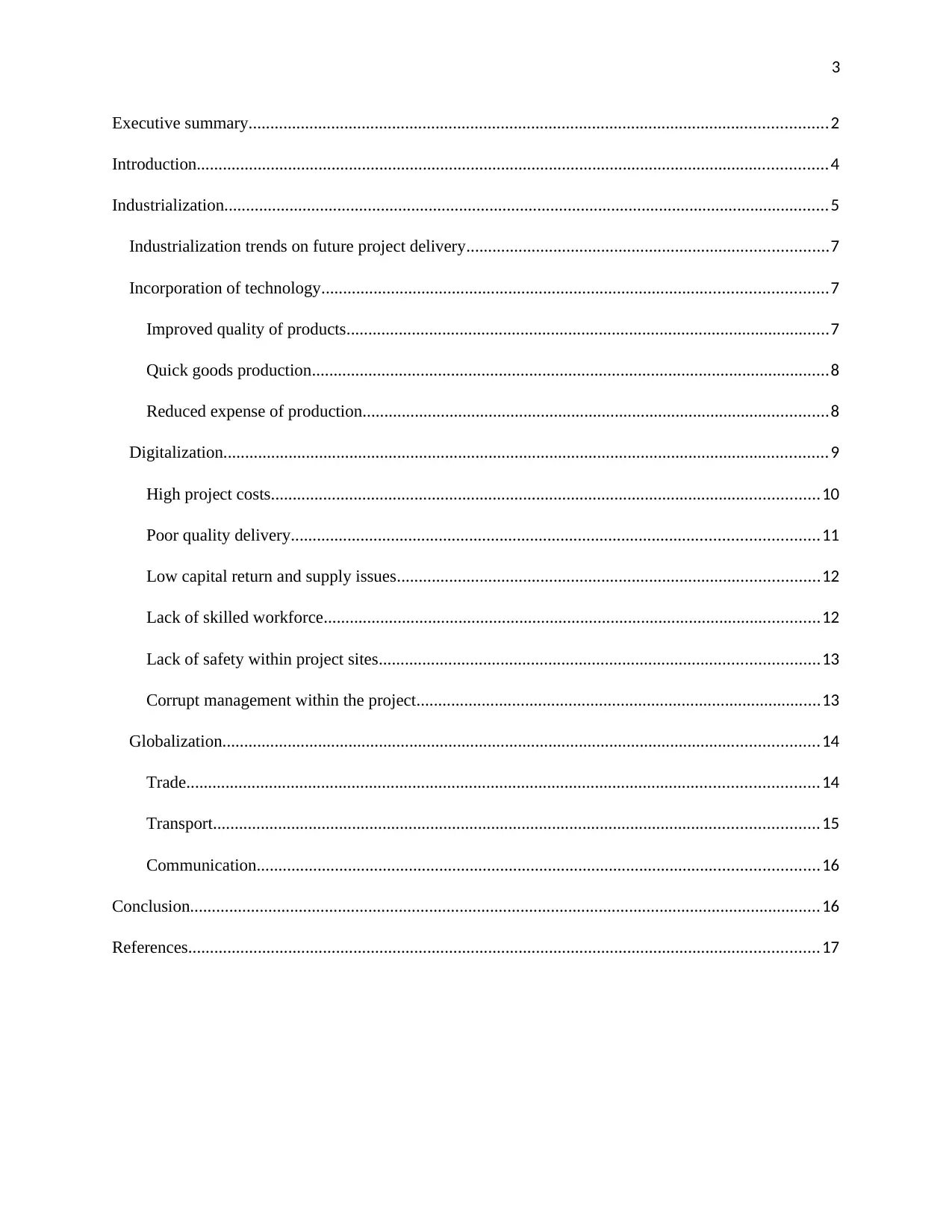
3
Executive summary.....................................................................................................................................2
Introduction.................................................................................................................................................4
Industrialization...........................................................................................................................................5
Industrialization trends on future project delivery...................................................................................7
Incorporation of technology....................................................................................................................7
Improved quality of products...............................................................................................................7
Quick goods production.......................................................................................................................8
Reduced expense of production...........................................................................................................8
Digitalization...........................................................................................................................................9
High project costs..............................................................................................................................10
Poor quality delivery.........................................................................................................................11
Low capital return and supply issues.................................................................................................12
Lack of skilled workforce..................................................................................................................12
Lack of safety within project sites.....................................................................................................13
Corrupt management within the project.............................................................................................13
Globalization.........................................................................................................................................14
Trade.................................................................................................................................................14
Transport...........................................................................................................................................15
Communication.................................................................................................................................16
Conclusion.................................................................................................................................................16
References.................................................................................................................................................17
Executive summary.....................................................................................................................................2
Introduction.................................................................................................................................................4
Industrialization...........................................................................................................................................5
Industrialization trends on future project delivery...................................................................................7
Incorporation of technology....................................................................................................................7
Improved quality of products...............................................................................................................7
Quick goods production.......................................................................................................................8
Reduced expense of production...........................................................................................................8
Digitalization...........................................................................................................................................9
High project costs..............................................................................................................................10
Poor quality delivery.........................................................................................................................11
Low capital return and supply issues.................................................................................................12
Lack of skilled workforce..................................................................................................................12
Lack of safety within project sites.....................................................................................................13
Corrupt management within the project.............................................................................................13
Globalization.........................................................................................................................................14
Trade.................................................................................................................................................14
Transport...........................................................................................................................................15
Communication.................................................................................................................................16
Conclusion.................................................................................................................................................16
References.................................................................................................................................................17
⊘ This is a preview!⊘
Do you want full access?
Subscribe today to unlock all pages.

Trusted by 1+ million students worldwide
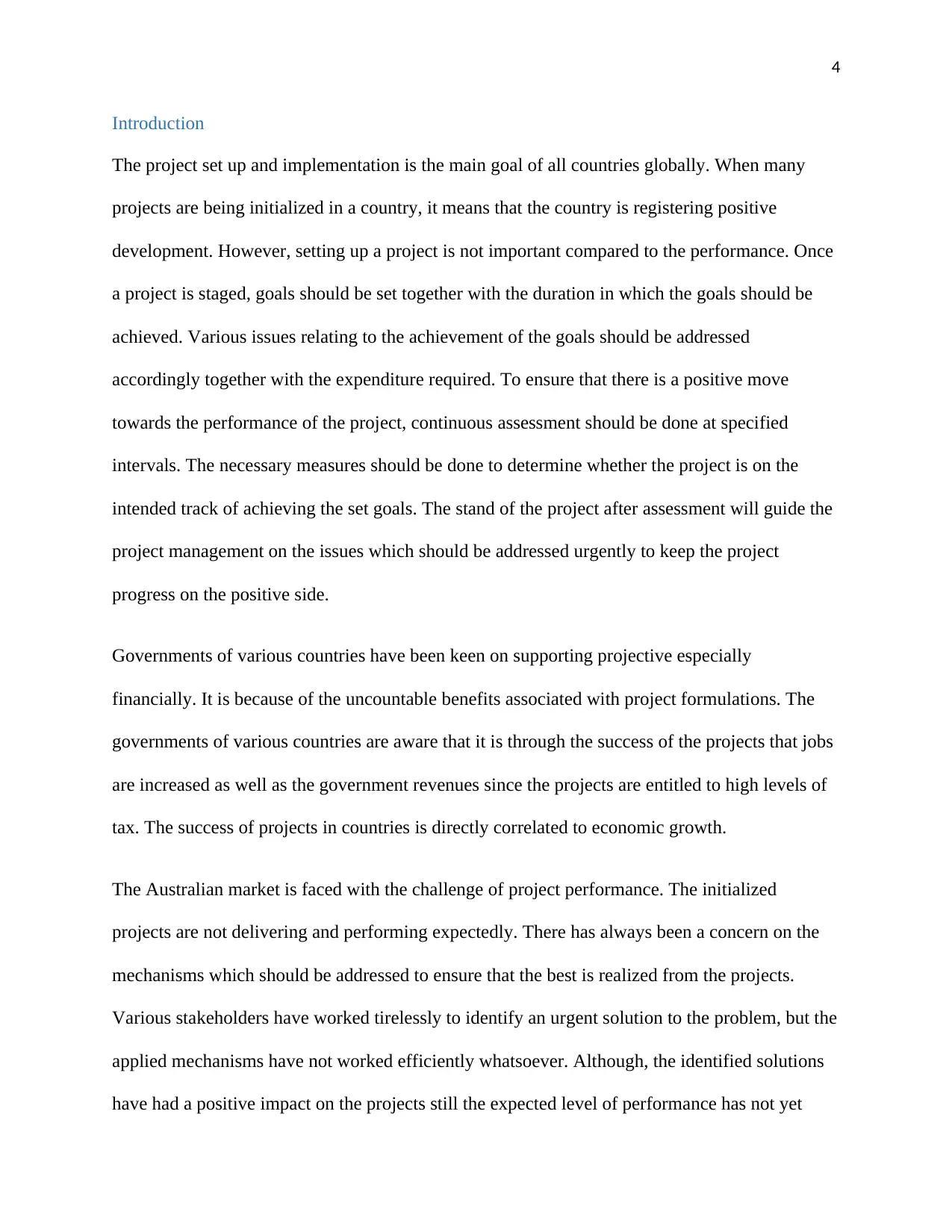
4
Introduction
The project set up and implementation is the main goal of all countries globally. When many
projects are being initialized in a country, it means that the country is registering positive
development. However, setting up a project is not important compared to the performance. Once
a project is staged, goals should be set together with the duration in which the goals should be
achieved. Various issues relating to the achievement of the goals should be addressed
accordingly together with the expenditure required. To ensure that there is a positive move
towards the performance of the project, continuous assessment should be done at specified
intervals. The necessary measures should be done to determine whether the project is on the
intended track of achieving the set goals. The stand of the project after assessment will guide the
project management on the issues which should be addressed urgently to keep the project
progress on the positive side.
Governments of various countries have been keen on supporting projective especially
financially. It is because of the uncountable benefits associated with project formulations. The
governments of various countries are aware that it is through the success of the projects that jobs
are increased as well as the government revenues since the projects are entitled to high levels of
tax. The success of projects in countries is directly correlated to economic growth.
The Australian market is faced with the challenge of project performance. The initialized
projects are not delivering and performing expectedly. There has always been a concern on the
mechanisms which should be addressed to ensure that the best is realized from the projects.
Various stakeholders have worked tirelessly to identify an urgent solution to the problem, but the
applied mechanisms have not worked efficiently whatsoever. Although, the identified solutions
have had a positive impact on the projects still the expected level of performance has not yet
Introduction
The project set up and implementation is the main goal of all countries globally. When many
projects are being initialized in a country, it means that the country is registering positive
development. However, setting up a project is not important compared to the performance. Once
a project is staged, goals should be set together with the duration in which the goals should be
achieved. Various issues relating to the achievement of the goals should be addressed
accordingly together with the expenditure required. To ensure that there is a positive move
towards the performance of the project, continuous assessment should be done at specified
intervals. The necessary measures should be done to determine whether the project is on the
intended track of achieving the set goals. The stand of the project after assessment will guide the
project management on the issues which should be addressed urgently to keep the project
progress on the positive side.
Governments of various countries have been keen on supporting projective especially
financially. It is because of the uncountable benefits associated with project formulations. The
governments of various countries are aware that it is through the success of the projects that jobs
are increased as well as the government revenues since the projects are entitled to high levels of
tax. The success of projects in countries is directly correlated to economic growth.
The Australian market is faced with the challenge of project performance. The initialized
projects are not delivering and performing expectedly. There has always been a concern on the
mechanisms which should be addressed to ensure that the best is realized from the projects.
Various stakeholders have worked tirelessly to identify an urgent solution to the problem, but the
applied mechanisms have not worked efficiently whatsoever. Although, the identified solutions
have had a positive impact on the projects still the expected level of performance has not yet
Paraphrase This Document
Need a fresh take? Get an instant paraphrase of this document with our AI Paraphraser
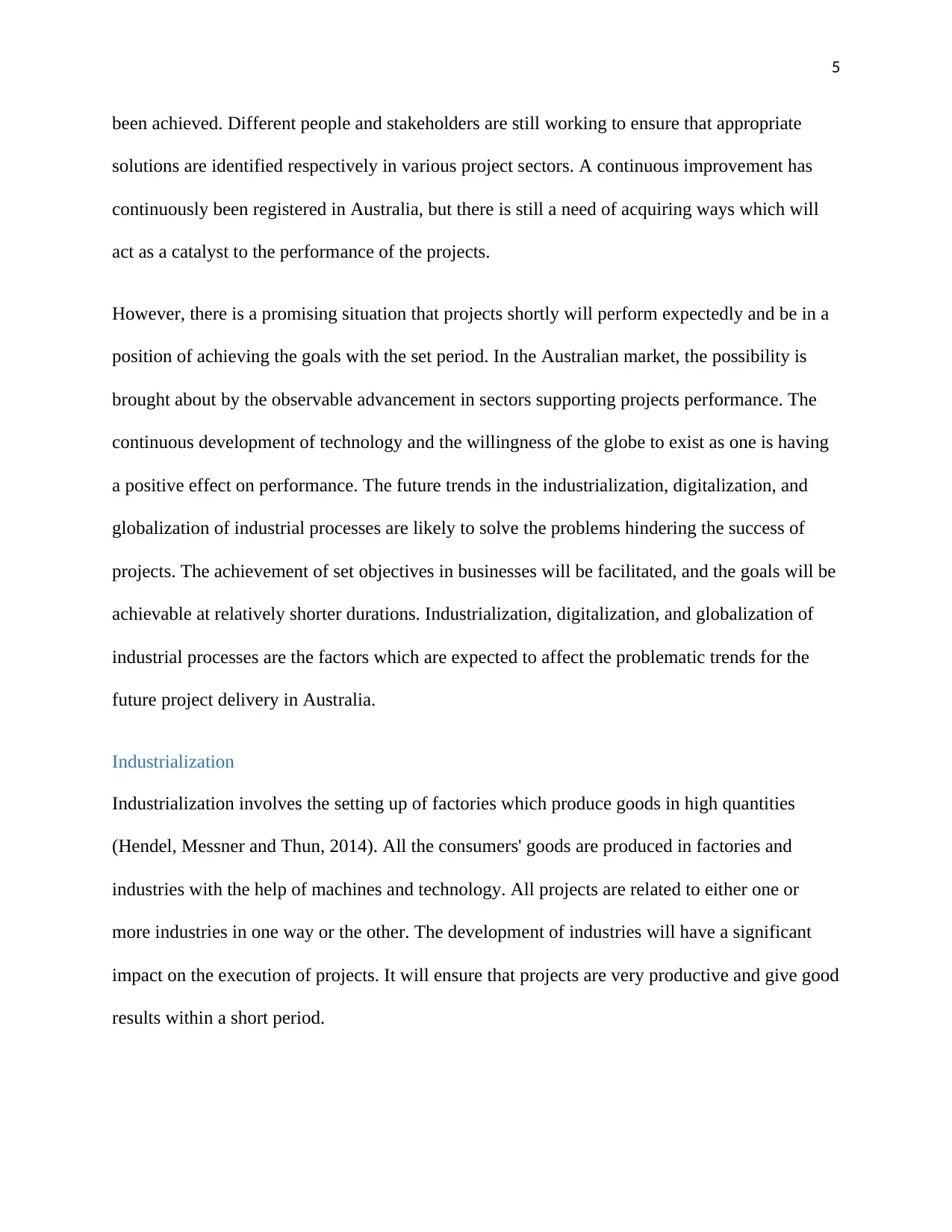
5
been achieved. Different people and stakeholders are still working to ensure that appropriate
solutions are identified respectively in various project sectors. A continuous improvement has
continuously been registered in Australia, but there is still a need of acquiring ways which will
act as a catalyst to the performance of the projects.
However, there is a promising situation that projects shortly will perform expectedly and be in a
position of achieving the goals with the set period. In the Australian market, the possibility is
brought about by the observable advancement in sectors supporting projects performance. The
continuous development of technology and the willingness of the globe to exist as one is having
a positive effect on performance. The future trends in the industrialization, digitalization, and
globalization of industrial processes are likely to solve the problems hindering the success of
projects. The achievement of set objectives in businesses will be facilitated, and the goals will be
achievable at relatively shorter durations. Industrialization, digitalization, and globalization of
industrial processes are the factors which are expected to affect the problematic trends for the
future project delivery in Australia.
Industrialization
Industrialization involves the setting up of factories which produce goods in high quantities
(Hendel, Messner and Thun, 2014). All the consumers' goods are produced in factories and
industries with the help of machines and technology. All projects are related to either one or
more industries in one way or the other. The development of industries will have a significant
impact on the execution of projects. It will ensure that projects are very productive and give good
results within a short period.
been achieved. Different people and stakeholders are still working to ensure that appropriate
solutions are identified respectively in various project sectors. A continuous improvement has
continuously been registered in Australia, but there is still a need of acquiring ways which will
act as a catalyst to the performance of the projects.
However, there is a promising situation that projects shortly will perform expectedly and be in a
position of achieving the goals with the set period. In the Australian market, the possibility is
brought about by the observable advancement in sectors supporting projects performance. The
continuous development of technology and the willingness of the globe to exist as one is having
a positive effect on performance. The future trends in the industrialization, digitalization, and
globalization of industrial processes are likely to solve the problems hindering the success of
projects. The achievement of set objectives in businesses will be facilitated, and the goals will be
achievable at relatively shorter durations. Industrialization, digitalization, and globalization of
industrial processes are the factors which are expected to affect the problematic trends for the
future project delivery in Australia.
Industrialization
Industrialization involves the setting up of factories which produce goods in high quantities
(Hendel, Messner and Thun, 2014). All the consumers' goods are produced in factories and
industries with the help of machines and technology. All projects are related to either one or
more industries in one way or the other. The development of industries will have a significant
impact on the execution of projects. It will ensure that projects are very productive and give good
results within a short period.
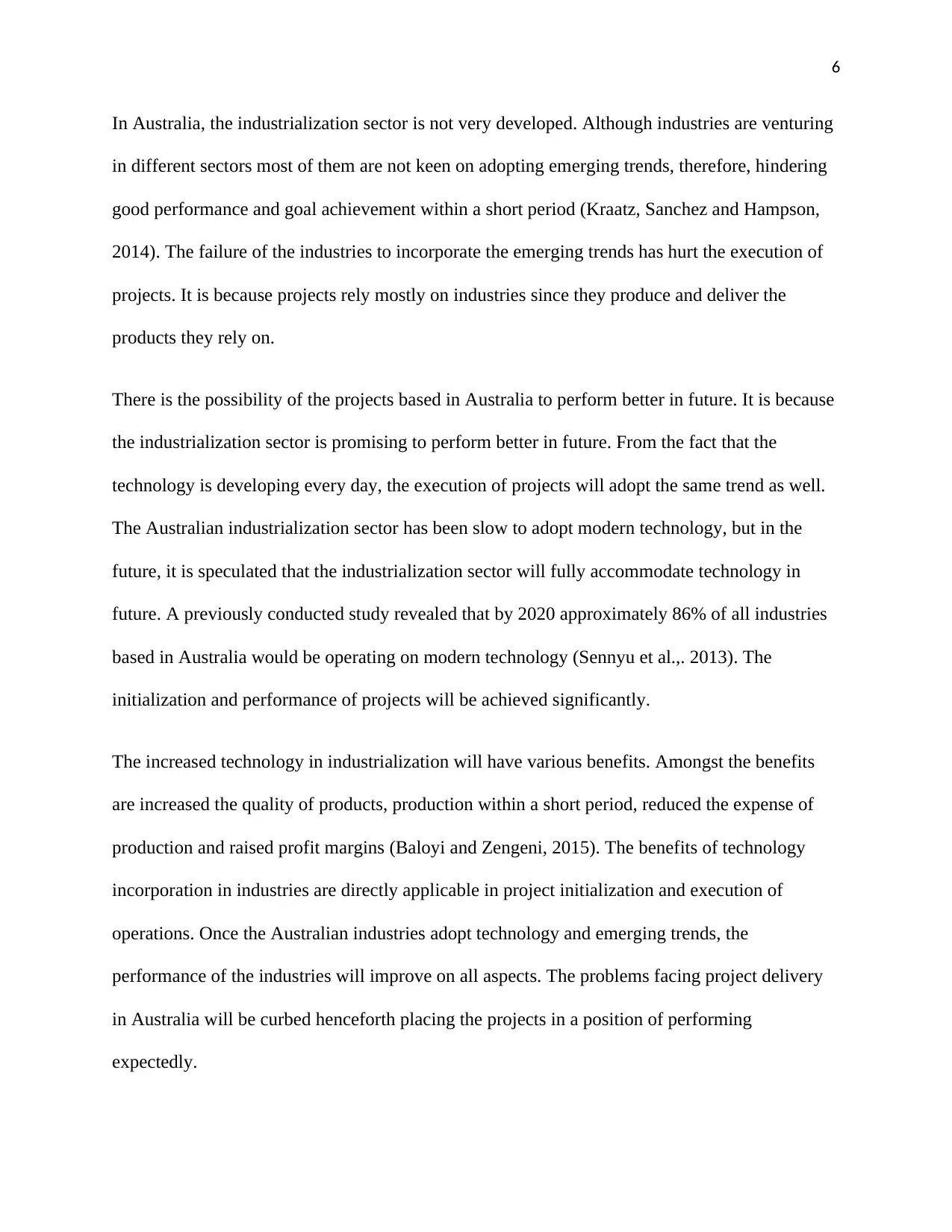
6
In Australia, the industrialization sector is not very developed. Although industries are venturing
in different sectors most of them are not keen on adopting emerging trends, therefore, hindering
good performance and goal achievement within a short period (Kraatz, Sanchez and Hampson,
2014). The failure of the industries to incorporate the emerging trends has hurt the execution of
projects. It is because projects rely mostly on industries since they produce and deliver the
products they rely on.
There is the possibility of the projects based in Australia to perform better in future. It is because
the industrialization sector is promising to perform better in future. From the fact that the
technology is developing every day, the execution of projects will adopt the same trend as well.
The Australian industrialization sector has been slow to adopt modern technology, but in the
future, it is speculated that the industrialization sector will fully accommodate technology in
future. A previously conducted study revealed that by 2020 approximately 86% of all industries
based in Australia would be operating on modern technology (Sennyu et al.,. 2013). The
initialization and performance of projects will be achieved significantly.
The increased technology in industrialization will have various benefits. Amongst the benefits
are increased the quality of products, production within a short period, reduced the expense of
production and raised profit margins (Baloyi and Zengeni, 2015). The benefits of technology
incorporation in industries are directly applicable in project initialization and execution of
operations. Once the Australian industries adopt technology and emerging trends, the
performance of the industries will improve on all aspects. The problems facing project delivery
in Australia will be curbed henceforth placing the projects in a position of performing
expectedly.
In Australia, the industrialization sector is not very developed. Although industries are venturing
in different sectors most of them are not keen on adopting emerging trends, therefore, hindering
good performance and goal achievement within a short period (Kraatz, Sanchez and Hampson,
2014). The failure of the industries to incorporate the emerging trends has hurt the execution of
projects. It is because projects rely mostly on industries since they produce and deliver the
products they rely on.
There is the possibility of the projects based in Australia to perform better in future. It is because
the industrialization sector is promising to perform better in future. From the fact that the
technology is developing every day, the execution of projects will adopt the same trend as well.
The Australian industrialization sector has been slow to adopt modern technology, but in the
future, it is speculated that the industrialization sector will fully accommodate technology in
future. A previously conducted study revealed that by 2020 approximately 86% of all industries
based in Australia would be operating on modern technology (Sennyu et al.,. 2013). The
initialization and performance of projects will be achieved significantly.
The increased technology in industrialization will have various benefits. Amongst the benefits
are increased the quality of products, production within a short period, reduced the expense of
production and raised profit margins (Baloyi and Zengeni, 2015). The benefits of technology
incorporation in industries are directly applicable in project initialization and execution of
operations. Once the Australian industries adopt technology and emerging trends, the
performance of the industries will improve on all aspects. The problems facing project delivery
in Australia will be curbed henceforth placing the projects in a position of performing
expectedly.
⊘ This is a preview!⊘
Do you want full access?
Subscribe today to unlock all pages.

Trusted by 1+ million students worldwide
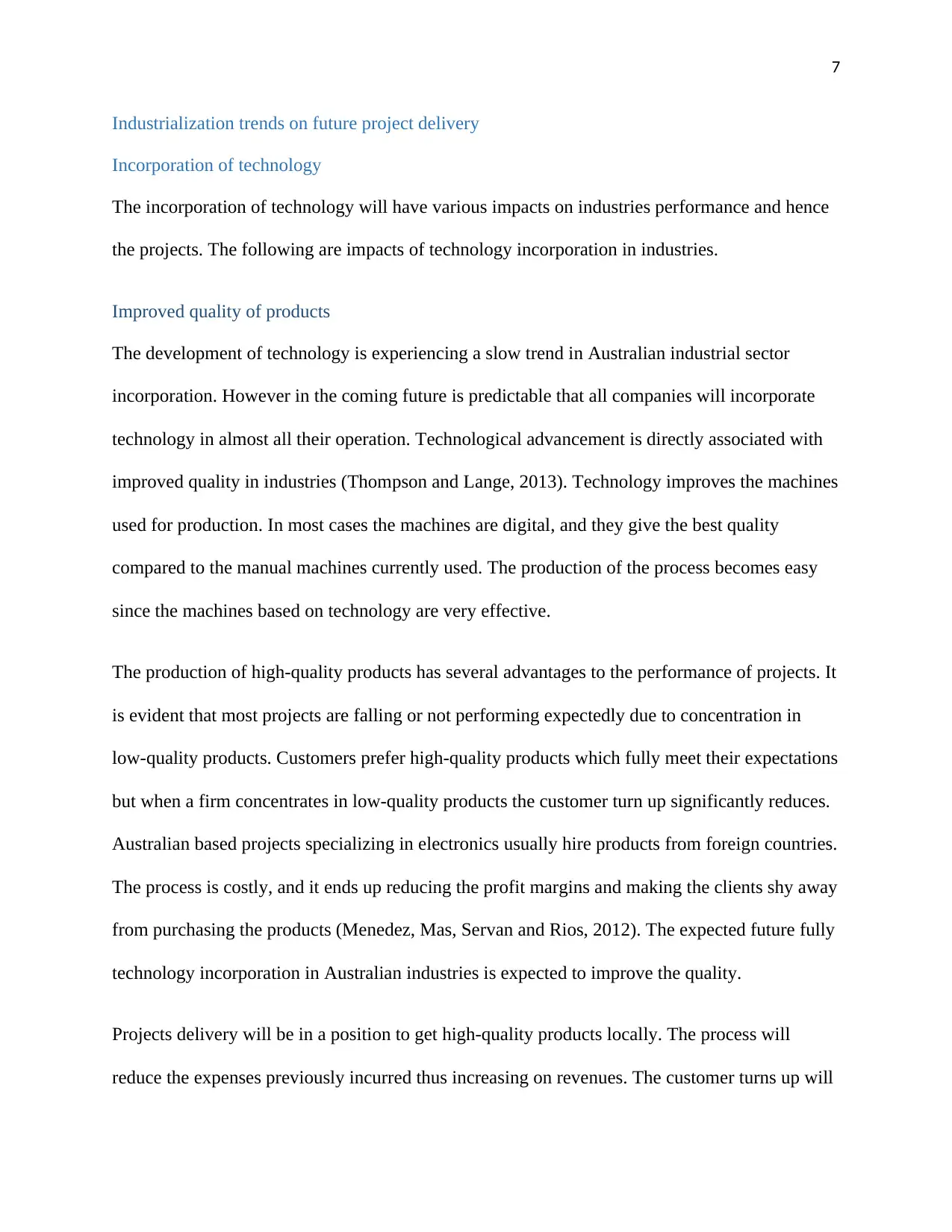
7
Industrialization trends on future project delivery
Incorporation of technology
The incorporation of technology will have various impacts on industries performance and hence
the projects. The following are impacts of technology incorporation in industries.
Improved quality of products
The development of technology is experiencing a slow trend in Australian industrial sector
incorporation. However in the coming future is predictable that all companies will incorporate
technology in almost all their operation. Technological advancement is directly associated with
improved quality in industries (Thompson and Lange, 2013). Technology improves the machines
used for production. In most cases the machines are digital, and they give the best quality
compared to the manual machines currently used. The production of the process becomes easy
since the machines based on technology are very effective.
The production of high-quality products has several advantages to the performance of projects. It
is evident that most projects are falling or not performing expectedly due to concentration in
low-quality products. Customers prefer high-quality products which fully meet their expectations
but when a firm concentrates in low-quality products the customer turn up significantly reduces.
Australian based projects specializing in electronics usually hire products from foreign countries.
The process is costly, and it ends up reducing the profit margins and making the clients shy away
from purchasing the products (Menedez, Mas, Servan and Rios, 2012). The expected future fully
technology incorporation in Australian industries is expected to improve the quality.
Projects delivery will be in a position to get high-quality products locally. The process will
reduce the expenses previously incurred thus increasing on revenues. The customer turns up will
Industrialization trends on future project delivery
Incorporation of technology
The incorporation of technology will have various impacts on industries performance and hence
the projects. The following are impacts of technology incorporation in industries.
Improved quality of products
The development of technology is experiencing a slow trend in Australian industrial sector
incorporation. However in the coming future is predictable that all companies will incorporate
technology in almost all their operation. Technological advancement is directly associated with
improved quality in industries (Thompson and Lange, 2013). Technology improves the machines
used for production. In most cases the machines are digital, and they give the best quality
compared to the manual machines currently used. The production of the process becomes easy
since the machines based on technology are very effective.
The production of high-quality products has several advantages to the performance of projects. It
is evident that most projects are falling or not performing expectedly due to concentration in
low-quality products. Customers prefer high-quality products which fully meet their expectations
but when a firm concentrates in low-quality products the customer turn up significantly reduces.
Australian based projects specializing in electronics usually hire products from foreign countries.
The process is costly, and it ends up reducing the profit margins and making the clients shy away
from purchasing the products (Menedez, Mas, Servan and Rios, 2012). The expected future fully
technology incorporation in Australian industries is expected to improve the quality.
Projects delivery will be in a position to get high-quality products locally. The process will
reduce the expenses previously incurred thus increasing on revenues. The customer turns up will
Paraphrase This Document
Need a fresh take? Get an instant paraphrase of this document with our AI Paraphraser
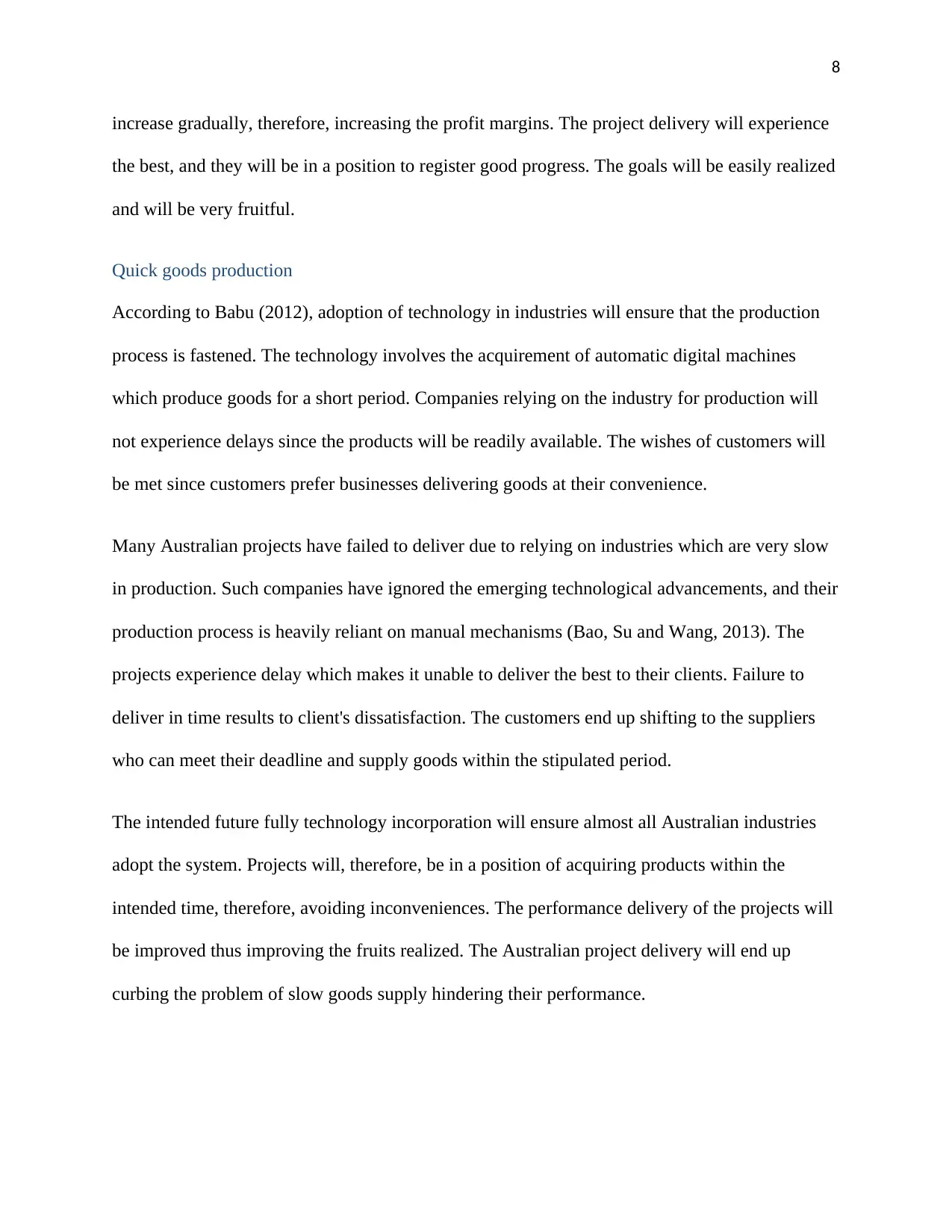
8
increase gradually, therefore, increasing the profit margins. The project delivery will experience
the best, and they will be in a position to register good progress. The goals will be easily realized
and will be very fruitful.
Quick goods production
According to Babu (2012), adoption of technology in industries will ensure that the production
process is fastened. The technology involves the acquirement of automatic digital machines
which produce goods for a short period. Companies relying on the industry for production will
not experience delays since the products will be readily available. The wishes of customers will
be met since customers prefer businesses delivering goods at their convenience.
Many Australian projects have failed to deliver due to relying on industries which are very slow
in production. Such companies have ignored the emerging technological advancements, and their
production process is heavily reliant on manual mechanisms (Bao, Su and Wang, 2013). The
projects experience delay which makes it unable to deliver the best to their clients. Failure to
deliver in time results to client's dissatisfaction. The customers end up shifting to the suppliers
who can meet their deadline and supply goods within the stipulated period.
The intended future fully technology incorporation will ensure almost all Australian industries
adopt the system. Projects will, therefore, be in a position of acquiring products within the
intended time, therefore, avoiding inconveniences. The performance delivery of the projects will
be improved thus improving the fruits realized. The Australian project delivery will end up
curbing the problem of slow goods supply hindering their performance.
increase gradually, therefore, increasing the profit margins. The project delivery will experience
the best, and they will be in a position to register good progress. The goals will be easily realized
and will be very fruitful.
Quick goods production
According to Babu (2012), adoption of technology in industries will ensure that the production
process is fastened. The technology involves the acquirement of automatic digital machines
which produce goods for a short period. Companies relying on the industry for production will
not experience delays since the products will be readily available. The wishes of customers will
be met since customers prefer businesses delivering goods at their convenience.
Many Australian projects have failed to deliver due to relying on industries which are very slow
in production. Such companies have ignored the emerging technological advancements, and their
production process is heavily reliant on manual mechanisms (Bao, Su and Wang, 2013). The
projects experience delay which makes it unable to deliver the best to their clients. Failure to
deliver in time results to client's dissatisfaction. The customers end up shifting to the suppliers
who can meet their deadline and supply goods within the stipulated period.
The intended future fully technology incorporation will ensure almost all Australian industries
adopt the system. Projects will, therefore, be in a position of acquiring products within the
intended time, therefore, avoiding inconveniences. The performance delivery of the projects will
be improved thus improving the fruits realized. The Australian project delivery will end up
curbing the problem of slow goods supply hindering their performance.
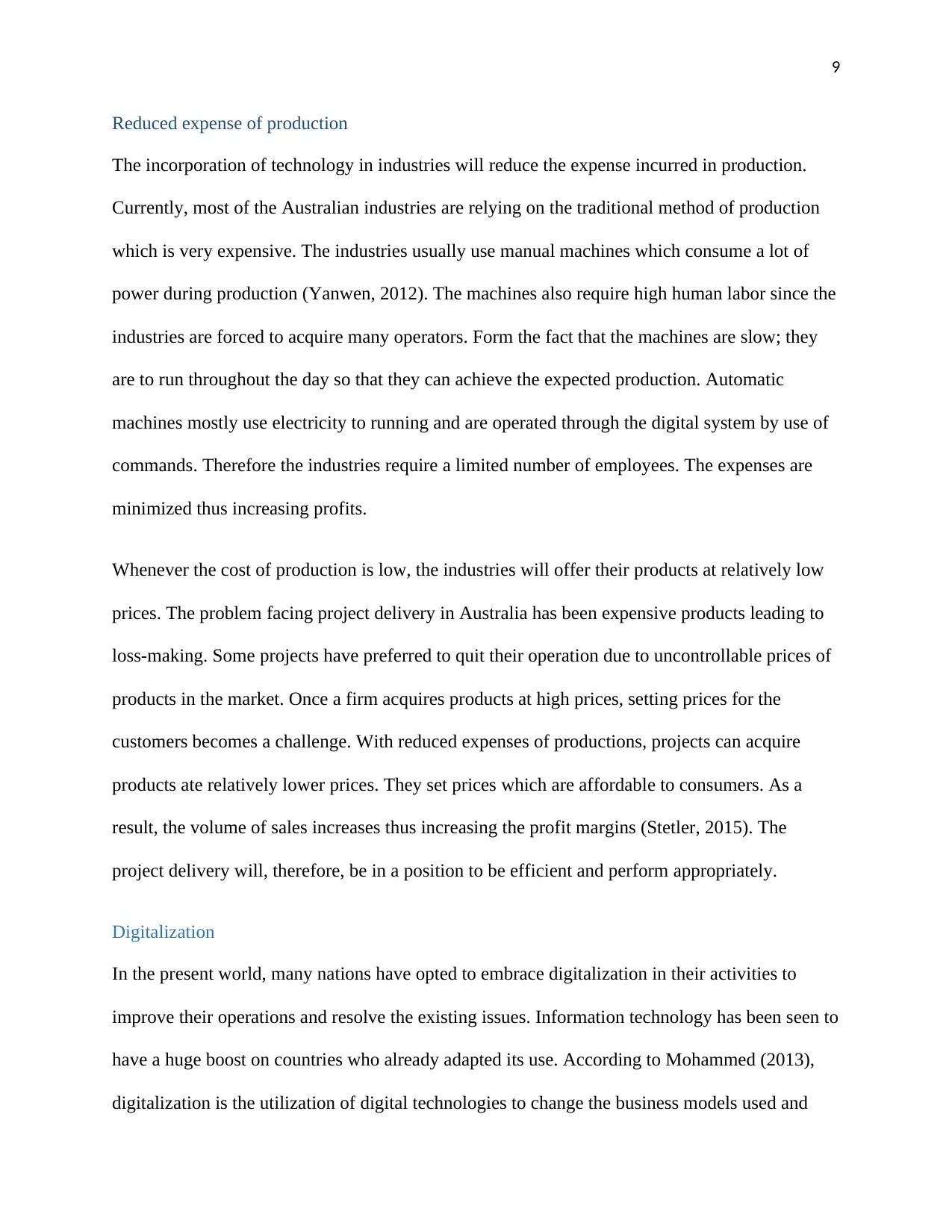
9
Reduced expense of production
The incorporation of technology in industries will reduce the expense incurred in production.
Currently, most of the Australian industries are relying on the traditional method of production
which is very expensive. The industries usually use manual machines which consume a lot of
power during production (Yanwen, 2012). The machines also require high human labor since the
industries are forced to acquire many operators. Form the fact that the machines are slow; they
are to run throughout the day so that they can achieve the expected production. Automatic
machines mostly use electricity to running and are operated through the digital system by use of
commands. Therefore the industries require a limited number of employees. The expenses are
minimized thus increasing profits.
Whenever the cost of production is low, the industries will offer their products at relatively low
prices. The problem facing project delivery in Australia has been expensive products leading to
loss-making. Some projects have preferred to quit their operation due to uncontrollable prices of
products in the market. Once a firm acquires products at high prices, setting prices for the
customers becomes a challenge. With reduced expenses of productions, projects can acquire
products ate relatively lower prices. They set prices which are affordable to consumers. As a
result, the volume of sales increases thus increasing the profit margins (Stetler, 2015). The
project delivery will, therefore, be in a position to be efficient and perform appropriately.
Digitalization
In the present world, many nations have opted to embrace digitalization in their activities to
improve their operations and resolve the existing issues. Information technology has been seen to
have a huge boost on countries who already adapted its use. According to Mohammed (2013),
digitalization is the utilization of digital technologies to change the business models used and
Reduced expense of production
The incorporation of technology in industries will reduce the expense incurred in production.
Currently, most of the Australian industries are relying on the traditional method of production
which is very expensive. The industries usually use manual machines which consume a lot of
power during production (Yanwen, 2012). The machines also require high human labor since the
industries are forced to acquire many operators. Form the fact that the machines are slow; they
are to run throughout the day so that they can achieve the expected production. Automatic
machines mostly use electricity to running and are operated through the digital system by use of
commands. Therefore the industries require a limited number of employees. The expenses are
minimized thus increasing profits.
Whenever the cost of production is low, the industries will offer their products at relatively low
prices. The problem facing project delivery in Australia has been expensive products leading to
loss-making. Some projects have preferred to quit their operation due to uncontrollable prices of
products in the market. Once a firm acquires products at high prices, setting prices for the
customers becomes a challenge. With reduced expenses of productions, projects can acquire
products ate relatively lower prices. They set prices which are affordable to consumers. As a
result, the volume of sales increases thus increasing the profit margins (Stetler, 2015). The
project delivery will, therefore, be in a position to be efficient and perform appropriately.
Digitalization
In the present world, many nations have opted to embrace digitalization in their activities to
improve their operations and resolve the existing issues. Information technology has been seen to
have a huge boost on countries who already adapted its use. According to Mohammed (2013),
digitalization is the utilization of digital technologies to change the business models used and
⊘ This is a preview!⊘
Do you want full access?
Subscribe today to unlock all pages.

Trusted by 1+ million students worldwide
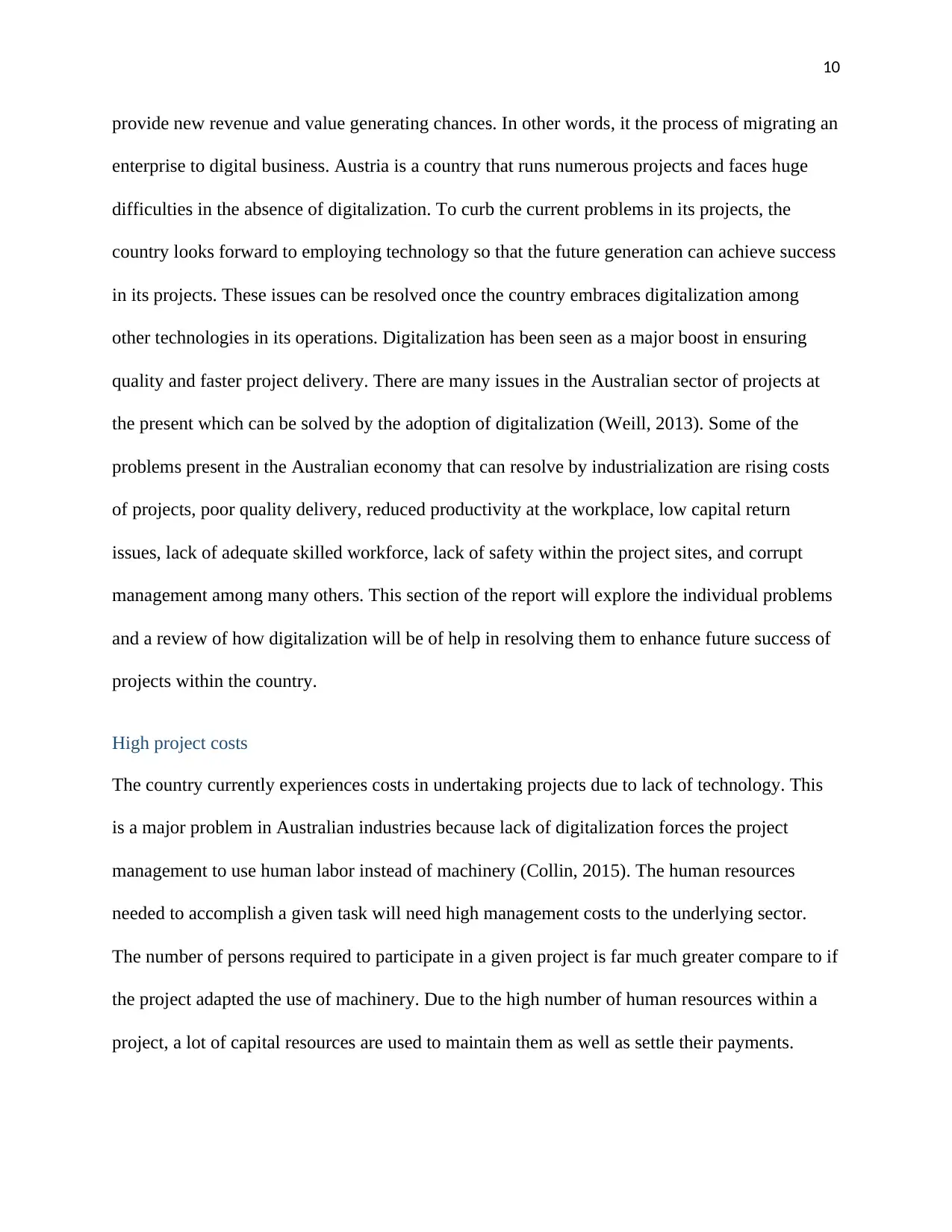
10
provide new revenue and value generating chances. In other words, it the process of migrating an
enterprise to digital business. Austria is a country that runs numerous projects and faces huge
difficulties in the absence of digitalization. To curb the current problems in its projects, the
country looks forward to employing technology so that the future generation can achieve success
in its projects. These issues can be resolved once the country embraces digitalization among
other technologies in its operations. Digitalization has been seen as a major boost in ensuring
quality and faster project delivery. There are many issues in the Australian sector of projects at
the present which can be solved by the adoption of digitalization (Weill, 2013). Some of the
problems present in the Australian economy that can resolve by industrialization are rising costs
of projects, poor quality delivery, reduced productivity at the workplace, low capital return
issues, lack of adequate skilled workforce, lack of safety within the project sites, and corrupt
management among many others. This section of the report will explore the individual problems
and a review of how digitalization will be of help in resolving them to enhance future success of
projects within the country.
High project costs
The country currently experiences costs in undertaking projects due to lack of technology. This
is a major problem in Australian industries because lack of digitalization forces the project
management to use human labor instead of machinery (Collin, 2015). The human resources
needed to accomplish a given task will need high management costs to the underlying sector.
The number of persons required to participate in a given project is far much greater compare to if
the project adapted the use of machinery. Due to the high number of human resources within a
project, a lot of capital resources are used to maintain them as well as settle their payments.
provide new revenue and value generating chances. In other words, it the process of migrating an
enterprise to digital business. Austria is a country that runs numerous projects and faces huge
difficulties in the absence of digitalization. To curb the current problems in its projects, the
country looks forward to employing technology so that the future generation can achieve success
in its projects. These issues can be resolved once the country embraces digitalization among
other technologies in its operations. Digitalization has been seen as a major boost in ensuring
quality and faster project delivery. There are many issues in the Australian sector of projects at
the present which can be solved by the adoption of digitalization (Weill, 2013). Some of the
problems present in the Australian economy that can resolve by industrialization are rising costs
of projects, poor quality delivery, reduced productivity at the workplace, low capital return
issues, lack of adequate skilled workforce, lack of safety within the project sites, and corrupt
management among many others. This section of the report will explore the individual problems
and a review of how digitalization will be of help in resolving them to enhance future success of
projects within the country.
High project costs
The country currently experiences costs in undertaking projects due to lack of technology. This
is a major problem in Australian industries because lack of digitalization forces the project
management to use human labor instead of machinery (Collin, 2015). The human resources
needed to accomplish a given task will need high management costs to the underlying sector.
The number of persons required to participate in a given project is far much greater compare to if
the project adapted the use of machinery. Due to the high number of human resources within a
project, a lot of capital resources are used to maintain them as well as settle their payments.
Paraphrase This Document
Need a fresh take? Get an instant paraphrase of this document with our AI Paraphraser
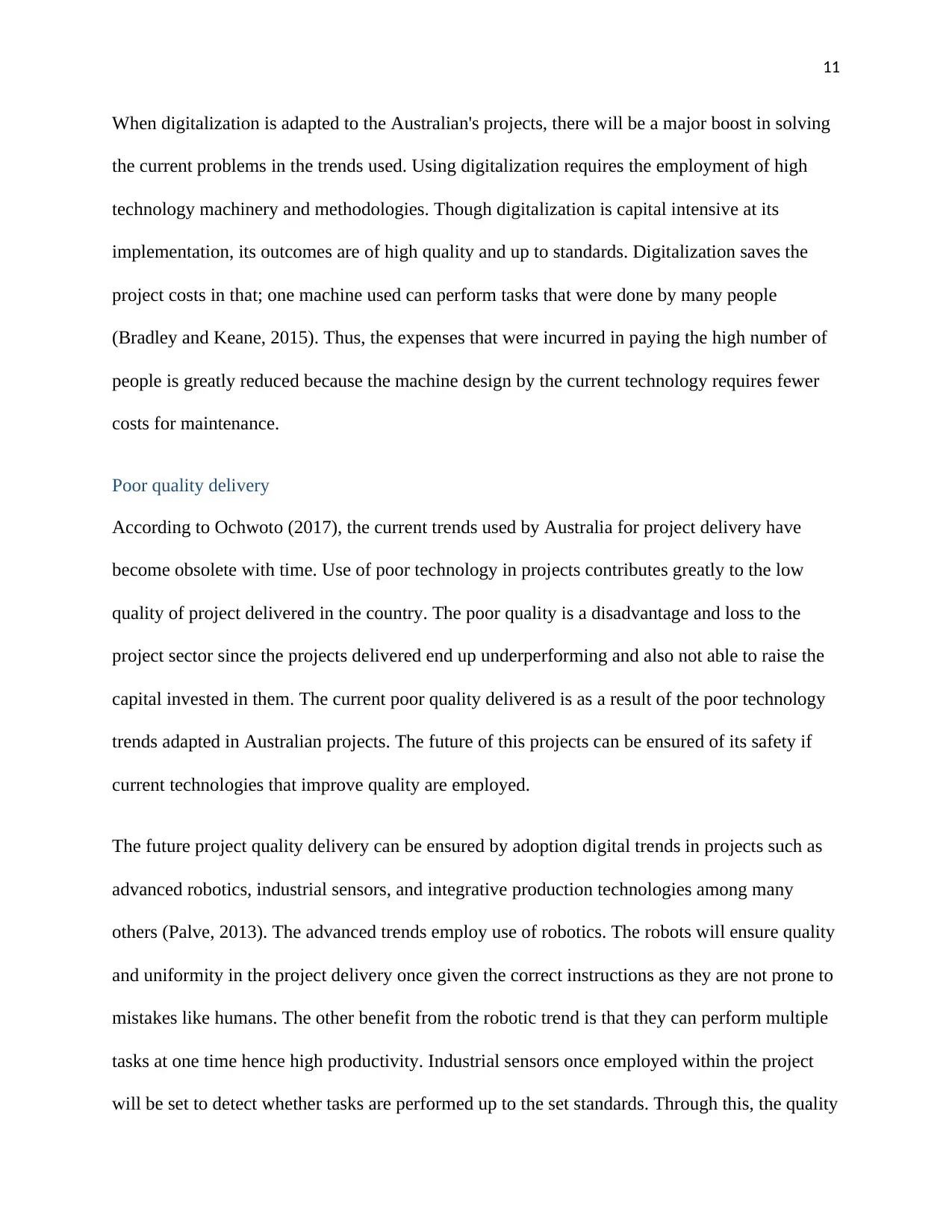
11
When digitalization is adapted to the Australian's projects, there will be a major boost in solving
the current problems in the trends used. Using digitalization requires the employment of high
technology machinery and methodologies. Though digitalization is capital intensive at its
implementation, its outcomes are of high quality and up to standards. Digitalization saves the
project costs in that; one machine used can perform tasks that were done by many people
(Bradley and Keane, 2015). Thus, the expenses that were incurred in paying the high number of
people is greatly reduced because the machine design by the current technology requires fewer
costs for maintenance.
Poor quality delivery
According to Ochwoto (2017), the current trends used by Australia for project delivery have
become obsolete with time. Use of poor technology in projects contributes greatly to the low
quality of project delivered in the country. The poor quality is a disadvantage and loss to the
project sector since the projects delivered end up underperforming and also not able to raise the
capital invested in them. The current poor quality delivered is as a result of the poor technology
trends adapted in Australian projects. The future of this projects can be ensured of its safety if
current technologies that improve quality are employed.
The future project quality delivery can be ensured by adoption digital trends in projects such as
advanced robotics, industrial sensors, and integrative production technologies among many
others (Palve, 2013). The advanced trends employ use of robotics. The robots will ensure quality
and uniformity in the project delivery once given the correct instructions as they are not prone to
mistakes like humans. The other benefit from the robotic trend is that they can perform multiple
tasks at one time hence high productivity. Industrial sensors once employed within the project
will be set to detect whether tasks are performed up to the set standards. Through this, the quality
When digitalization is adapted to the Australian's projects, there will be a major boost in solving
the current problems in the trends used. Using digitalization requires the employment of high
technology machinery and methodologies. Though digitalization is capital intensive at its
implementation, its outcomes are of high quality and up to standards. Digitalization saves the
project costs in that; one machine used can perform tasks that were done by many people
(Bradley and Keane, 2015). Thus, the expenses that were incurred in paying the high number of
people is greatly reduced because the machine design by the current technology requires fewer
costs for maintenance.
Poor quality delivery
According to Ochwoto (2017), the current trends used by Australia for project delivery have
become obsolete with time. Use of poor technology in projects contributes greatly to the low
quality of project delivered in the country. The poor quality is a disadvantage and loss to the
project sector since the projects delivered end up underperforming and also not able to raise the
capital invested in them. The current poor quality delivered is as a result of the poor technology
trends adapted in Australian projects. The future of this projects can be ensured of its safety if
current technologies that improve quality are employed.
The future project quality delivery can be ensured by adoption digital trends in projects such as
advanced robotics, industrial sensors, and integrative production technologies among many
others (Palve, 2013). The advanced trends employ use of robotics. The robots will ensure quality
and uniformity in the project delivery once given the correct instructions as they are not prone to
mistakes like humans. The other benefit from the robotic trend is that they can perform multiple
tasks at one time hence high productivity. Industrial sensors once employed within the project
will be set to detect whether tasks are performed up to the set standards. Through this, the quality
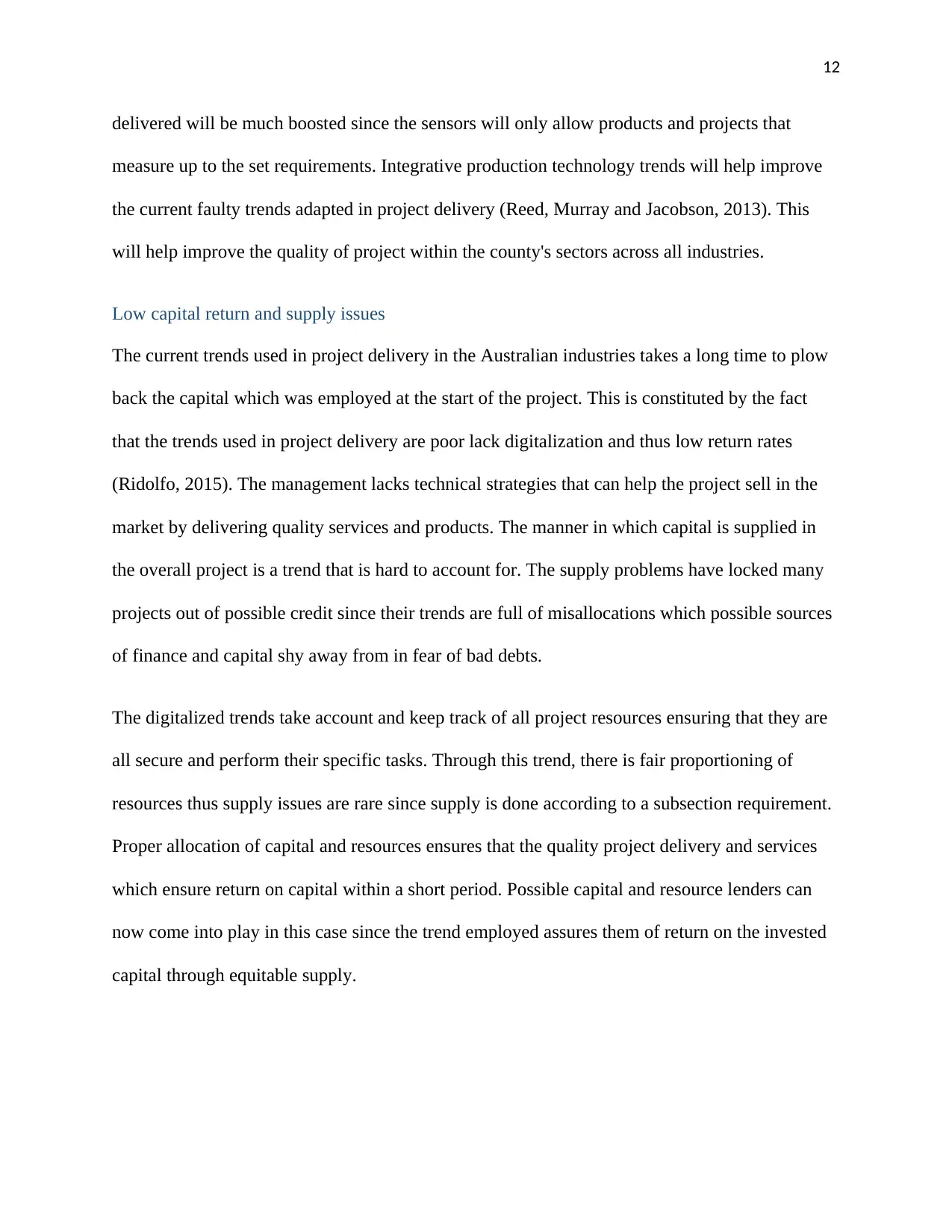
12
delivered will be much boosted since the sensors will only allow products and projects that
measure up to the set requirements. Integrative production technology trends will help improve
the current faulty trends adapted in project delivery (Reed, Murray and Jacobson, 2013). This
will help improve the quality of project within the county's sectors across all industries.
Low capital return and supply issues
The current trends used in project delivery in the Australian industries takes a long time to plow
back the capital which was employed at the start of the project. This is constituted by the fact
that the trends used in project delivery are poor lack digitalization and thus low return rates
(Ridolfo, 2015). The management lacks technical strategies that can help the project sell in the
market by delivering quality services and products. The manner in which capital is supplied in
the overall project is a trend that is hard to account for. The supply problems have locked many
projects out of possible credit since their trends are full of misallocations which possible sources
of finance and capital shy away from in fear of bad debts.
The digitalized trends take account and keep track of all project resources ensuring that they are
all secure and perform their specific tasks. Through this trend, there is fair proportioning of
resources thus supply issues are rare since supply is done according to a subsection requirement.
Proper allocation of capital and resources ensures that the quality project delivery and services
which ensure return on capital within a short period. Possible capital and resource lenders can
now come into play in this case since the trend employed assures them of return on the invested
capital through equitable supply.
delivered will be much boosted since the sensors will only allow products and projects that
measure up to the set requirements. Integrative production technology trends will help improve
the current faulty trends adapted in project delivery (Reed, Murray and Jacobson, 2013). This
will help improve the quality of project within the county's sectors across all industries.
Low capital return and supply issues
The current trends used in project delivery in the Australian industries takes a long time to plow
back the capital which was employed at the start of the project. This is constituted by the fact
that the trends used in project delivery are poor lack digitalization and thus low return rates
(Ridolfo, 2015). The management lacks technical strategies that can help the project sell in the
market by delivering quality services and products. The manner in which capital is supplied in
the overall project is a trend that is hard to account for. The supply problems have locked many
projects out of possible credit since their trends are full of misallocations which possible sources
of finance and capital shy away from in fear of bad debts.
The digitalized trends take account and keep track of all project resources ensuring that they are
all secure and perform their specific tasks. Through this trend, there is fair proportioning of
resources thus supply issues are rare since supply is done according to a subsection requirement.
Proper allocation of capital and resources ensures that the quality project delivery and services
which ensure return on capital within a short period. Possible capital and resource lenders can
now come into play in this case since the trend employed assures them of return on the invested
capital through equitable supply.
⊘ This is a preview!⊘
Do you want full access?
Subscribe today to unlock all pages.

Trusted by 1+ million students worldwide
1 out of 22
Related Documents
Your All-in-One AI-Powered Toolkit for Academic Success.
+13062052269
info@desklib.com
Available 24*7 on WhatsApp / Email
![[object Object]](/_next/static/media/star-bottom.7253800d.svg)
Unlock your academic potential
Copyright © 2020–2025 A2Z Services. All Rights Reserved. Developed and managed by ZUCOL.





